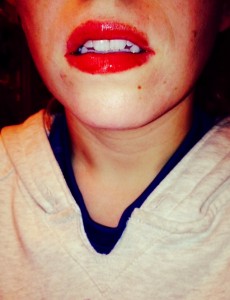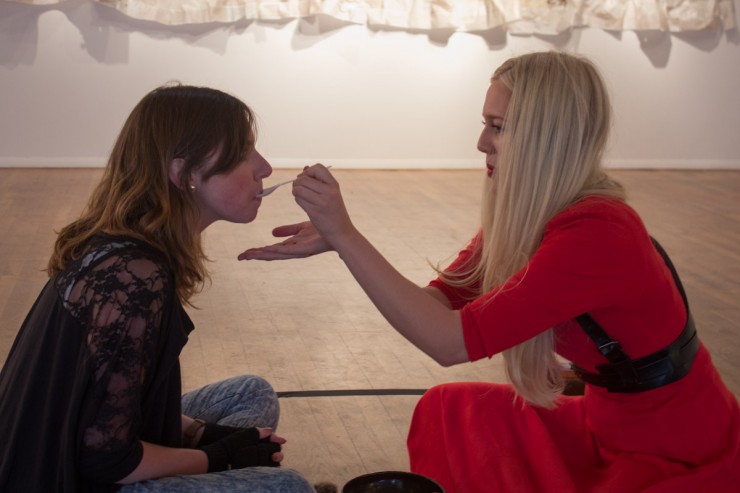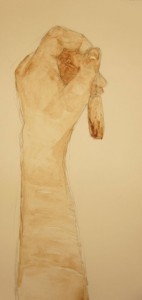Diana Alvarez
I believe my project fulfills the call for art because I use menstrual fluid as the primary source for the art and encouraged participants to confront their discomforts with menstruation. Empowerment was my main goal with the art, both for myself and for menstruators as a whole. The project was called “Cup of Flow” and involved my inviting a group of women over to my home to watch me interact with my menstrual blood and my menstrual cup. I interacted with the blood in a hands-on way that involved touching it, smelling it, wearing it as lipstick, and tasting it. My goal was to push the boundaries of what most of the attendees had probably experienced before. I also used a speculum to allow the attendees to watch me menstruate directly from the cervix, the source. I had accumulated some menstrual blood in a mason jar prior to the event that had coagulated and allowed for the guests to pass it around and examine it. The menstrual cup was an important element because we took the conversation into a broader spectrum of environmentalism. Everyone was allowed to take pictures and post to social media using the hashtag (#cupofflow). The images were flagged by Facebook users as “obscene,” but when threatened to have them removed we launched a formal complaint asking Facebook to reconsider by explaining that menstrual blood is natural and not trauma induced. The pictures ultimately remained posted to the website. In the revolution there will be blood!
Gabriella Boros
Niddah: The topic of female victimaztion has been covered in the news with alarming frequency in the past year. This provoked me to turn to my own religious roots and learn about the Judaic tradition of Niddah, the14 day separation of women during and after menstruation. In traditional homes, women cannot have contact with their husbands nor participate in religious observation during Niddah. In this project, I project both the negativity that is inherent in the Talmudic view of women’s cycles as well as my own ambivalence to the bodily process.
Niddah: Seven Days: Over the course of seven panels an overprinted image emerges both reaching out and inaccessible. The last print shows a complete hand in black against a watery background, a visual reference to the tradition of ritual immersion that marks the completion of Niddah.
The Women Series: I reflect on how traditional women experience societal exclusion during their periods. The ghostlike images roughly flesh out each woman’s shape, their presence described by their absence. I gave these women a strong stance, unafraid and proud, yet their isolation is undeniable. Whether the isolation is societal or self-imposed it is unclear.
The Curses: These embroidered depictions show some of the physical manifestations of menstruants. The banners refer to a family coat of arms which displays negative sideffects with the pride that one hangs a family crest. At the bottom of every banner are bdikah cloths painted with abstractions. These are used by Jewish women to check for purity in the seven days following menses.
Ingrid Goldbloom Bloch
I love hardware stores. As a little girl, I would accompany my father on his errands and get lost in the aisles imagining all the things I could make from the bits and pieces I came across. Since that time, hardware stores have been the inspiration for many of the mixed-media sculptures I create. I see the beauty in common objects. Each bit and piece is a mini-sculpture to me. The shape of each singular object, the texture and the transformation of grouping small bits into a larger whole is what drives my art. By using everyday items and transforming them into something entirely different from their intended purpose, I try to draw the viewer in to take a closer look at materials and objects that ordinarily go unnoticed.
Lucy Madeline
At the root of all my work is a fundamental belief in the power of image and an understanding of the body as the primary site of knowing the world. I see images and image making as a practice in magic as much as theory: I have found that by simply re-appropriating the female form through my work, I am able to simultaneously re-appropriate the female experience. I take back both personal cultural space through the making of alternative images of the abstract and literal female figure.
Working in painting, drawing, ephemeral sculpture, performance and video, I investigate the female body as it pertains to time, language and “other”. In my current work, I explore the contemporary implications of menstrual taboo, menstrual seclusion and menstrual rite in the context of everyday life. I consider the body directly through the methodical collection of my own hair and blood. I sew my hair into paper, drawing various stages of cellular mitosis and the replication of mother cells into daughter cells, investigating ideas of time, genesis and the m(other)ness of the body. I also make objects out of primal materials of the earth: pinesap, pine needles, dirt, beeswax, clay and bone ash, using natural pigments like yellow ochre and iron oxide. I use these materials to both cast and sculpt the female form.
I am curious about the ritual aspects of form, object and image: how they can embody and impart mysteries and practices indigenous to the human species, especially forms located in the female body. I focus on areas of the body directly correlated to gender and female practices like nipples, breasts, blood, hair and ovaries.
Kyle
Kyle prefers to be called Kyle. Just Kyle. She made all of this “to deal.” She painted, sewed and stained these pieces to speak of what troubles her in her private mind. After years of dysphoria, she is coping and overcoming the hindrance of other people’s perception of her body and its functions. The use of menstrual blood in art has been part of that overcoming. In these pieces, she uses the external and internal of the body to explore craft and its relationship to gender. Through these menstrual images she hopes to create a relatable narrative about social conceptions of gender and menstruation. She extends an invitation to view these suspended moments to help others “to deal.”
For more information, visit www.wideningthecycle.com. For questions, please email the curator and exhibit planner, Jen Lewis, at info [at] wideningthecycle [dot] com.





